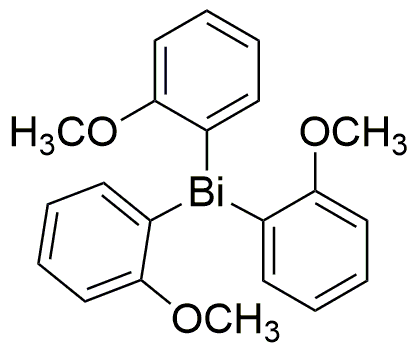Tris(2-methoxyphenyl)bismuthine is widely utilized in research focused on:
- Pharmaceutical Development: This compound serves as a potential precursor in the synthesis of bismuth-based drugs, which are being explored for their antimicrobial and anticancer properties.
- Material Science: It is used in the formulation of advanced materials, particularly in the development of semiconductors and photonic devices, due to its unique electronic properties.
- Organic Synthesis: Researchers employ this compound as a reagent in various organic reactions, facilitating the creation of complex organic molecules with high efficiency.
- Environmental Chemistry: It plays a role in studies related to heavy metal remediation, helping to understand and mitigate the effects of bismuth in environmental samples.
- Analytical Chemistry: This chemical is utilized in the development of analytical methods for detecting trace amounts of bismuth in various samples, enhancing the accuracy of environmental and clinical analyses.
General Information
Properties
Safety and Regulations
Applications
Tris(2-methoxyphenyl)bismuthine is widely utilized in research focused on:
- Pharmaceutical Development: This compound serves as a potential precursor in the synthesis of bismuth-based drugs, which are being explored for their antimicrobial and anticancer properties.
- Material Science: It is used in the formulation of advanced materials, particularly in the development of semiconductors and photonic devices, due to its unique electronic properties.
- Organic Synthesis: Researchers employ this compound as a reagent in various organic reactions, facilitating the creation of complex organic molecules with high efficiency.
- Environmental Chemistry: It plays a role in studies related to heavy metal remediation, helping to understand and mitigate the effects of bismuth in environmental samples.
- Analytical Chemistry: This chemical is utilized in the development of analytical methods for detecting trace amounts of bismuth in various samples, enhancing the accuracy of environmental and clinical analyses.
Documents
Safety Data Sheets (SDS)
The SDS provides comprehensive safety information on handling, storage, and disposal of the product.
Product Specification (PS)
The PS provides a comprehensive breakdown of the product’s properties, including chemical composition, physical state, purity, and storage requirements. It also details acceptable quality ranges and the product's intended applications.
Certificates of Analysis (COA)
Search for Certificates of Analysis (COA) by entering the products Lot Number. Lot and Batch Numbers can be found on a product’s label following the words ‘Lot’ or ‘Batch’.
Número de catálogo
Número de lote/lote
Certificates Of Origin (COO)
This COO confirms the country where the product was manufactured, and also details the materials and components used in it and whether it is derived from natural, synthetic, or other specific sources. This certificate may be required for customs, trade, and regulatory compliance.
Número de catálogo
Número de lote/lote
Safety Data Sheets (SDS)
The SDS provides comprehensive safety information on handling, storage, and disposal of the product.
DownloadProduct Specification (PS)
The PS provides a comprehensive breakdown of the product’s properties, including chemical composition, physical state, purity, and storage requirements. It also details acceptable quality ranges and the product's intended applications.
DownloadCertificates of Analysis (COA)
Search for Certificates of Analysis (COA) by entering the products Lot Number. Lot and Batch Numbers can be found on a product’s label following the words ‘Lot’ or ‘Batch’.
Número de catálogo
Número de lote/lote
Certificates Of Origin (COO)
This COO confirms the country where the product was manufactured, and also details the materials and components used in it and whether it is derived from natural, synthetic, or other specific sources. This certificate may be required for customs, trade, and regulatory compliance.


